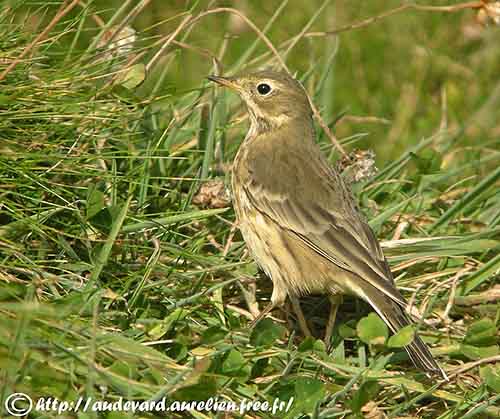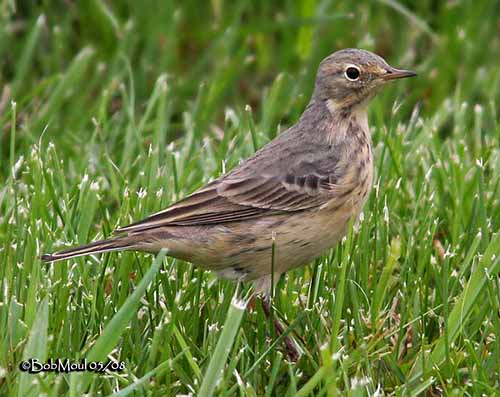
Fr: Pipit farlousane - Pipit d’Amérique
All: Pazifikpieper
Esp: Bisbita Norteamericano
Ita: Spioncello ventrerossiccio
Nd: Pacifische Waterpieper
Sd: Hedpiplärka
Photographers:
Aurélien Audevard
OUESSANT DIGISCOPING
Didier Buysse
Vision d’Oiseaux
Tom Grey
Tom Grey's Bird Pictures
Ken Havard
My Bird Gallery & Flickr gallery 1 & Flickr gallery 2
Bob Moul
Nature Photography
Text by Nicole Bouglouan
Sources :
HANDBOOK OF THE BIRDS OF THE WORLD Vol 9 - by Josep del Hoyo - Andrew Elliot - David Christie - Lynx Edicions - ISBN: 8487334695
FIELD GUIDE TO THE BIRDS OF NORTH AMERICA - National Geographic Society - ISBN: 0792274512
THE HANDBOOK OF BIRD IDENTIFICATION FOR EUROPE AND THE WESTERN PALEARCTIC by Mark Beaman, Steve Madge - C.Helm - ISBN: 0713639601
BirdLife International (BirdLife International)
All About Birds (Cornell Lab of Ornithology)
Bird Web (Seattle Audubon Society)
What Bird-The ultimate Bird Guide (Mitchell Waite)
Wikipedia, the free encyclopaedia
Surfbirds.com - For birders all over the world
Buff-bellied Pipit or American Pipit
Anthus rubescens
Passeriformes Order – Motacillidae Family
INTRODUCTION:
The Buff-bellied Pipit or American Pipit has wide range and can be seen on both sides of N Pacific Ocean.
This is a very typical pipit with upright stance and streaked breast and flanks. It often bobs the tail and walks on the ground rather than hops.
DESCRIPTION OF THE BIRD:
Biometrics:
Length: 14-17 cm
Wingspan: 24 cm
Weight: 21 g
The adult of nominate race in breeding plumage has grey upperparts with faint dark streaking. The flight-feathers are blackish with pale buff edges, whereas the pale tipped wing-coverts form two wingbars. The tail is blackish with white outer rectrices.

The underparts are orange-buff with variable streaking on breast and flanks, and the undertail-coverts are paler. Chin and throat are paler too, mostly pale buff to pinkish.
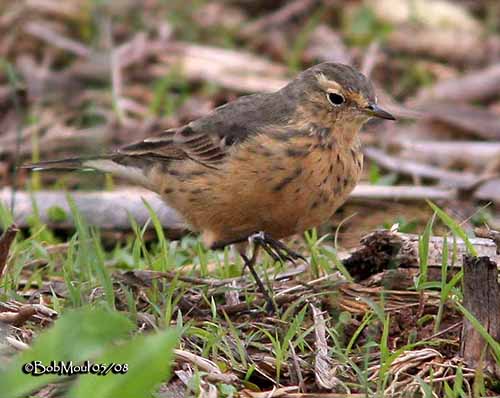
On the head, forehead and crown are grey. We can see a broad pale pinkish-buff supercilium, a buffy submoustachial stripe and also a darker malar stripe and patch, both can be variable.
The pointed bill is blackish-brown with yellow base. The eyes are dark brown, surrounded by narrow, white eyering. Legs and feet are blackish, with longer hind toe.
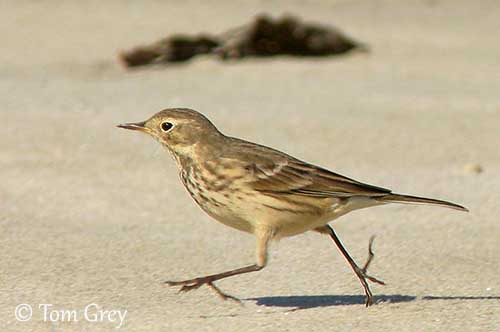
Both sexes are similar.
In non-breeding plumage, the upperparts are grey-brown with dark streaks on back and scapulars, and more conspicuous wingbars. The underparts are whitish, and sometimes brownish-buff. The dark streaking is more distinct than in breeding plumage. The legs can be sometimes pinkish.
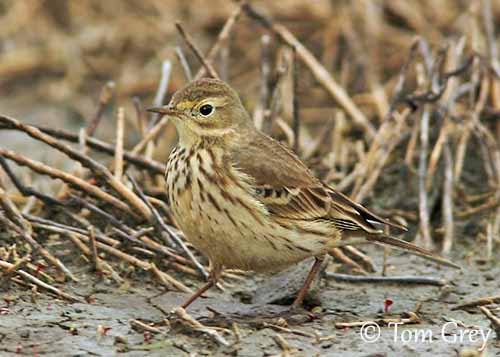
The juvenile resembles non-breeding adult with heavier streaking above, paler below, and it is less conspicuously streaked on flanks.
SUBSPECIES AND RANGE:
We can find four subspecies.
A.r. japonicus breeds in N, C, and E Russia, W Siberian Plateau, and from L Baikal region E to Chukotsk Peninsula. It is present too on Commander Is, Sakhalin and Kuril Is. It winters in S Asia.
This race has pale pinkish legs. In breeding plumage, it is paler rufous-cinnamon or pink-cinnamon below. It has distinct spots on cheeks, breast and flanks.
In non-breeding plumage, the upperparts are darker greyish-olive with black feather centres on mantle and scapulars, and conspicuous white wingbars. The underparts are whitish with more extensive blacker streaks and spots.
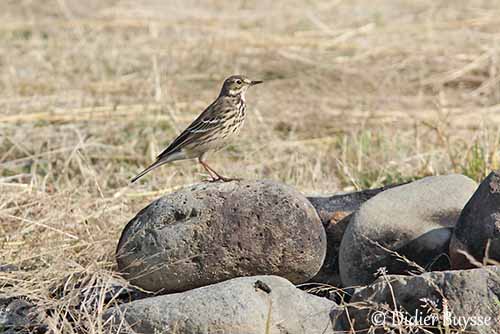
A.r. pacificus breeds W North America, Alaska and S to Oregon. It winters S to W Mexico.
This one is very similar to nominate. The underparts are slightly yellower in breeding plumage, with more distinct streaking. It is slightly paler below in winter plumage, with rather spotting than streaking. But there are numerous variations.
A.r. alticola breeds in C and S Rocky Mountains, and locally in mountains W to California. It winters S to Mexico.
This race in breeding plumage has darker orange-buff or more rufous sparsely streaked underparts. The malar stripe is indistinct or absent.
A.r. rubescens (described above) breeds in N and E Canada, W Greenland and extreme NE USA. It winters S to Central America.
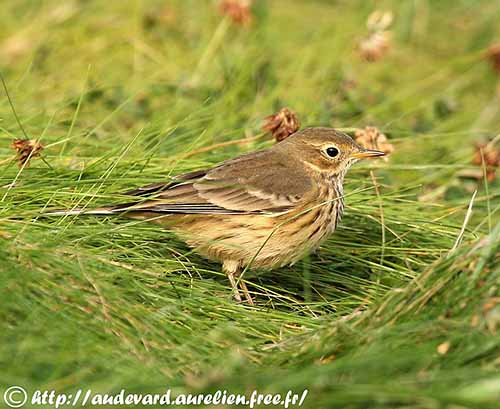
HABITAT:
The Buff-bellied Pipit or American Pipit of N American races breeds in arctic and alpine tundra, also on barren coasts in Labrador, or in pastures and cultivated areas, and higher on mountain slopes farther S, at least 2700 metres of elevation.
It winters in coastal marshes or along streams and lakes, on beaches and fields. During migration, it can be seen near rivers and lakes on open flats, in ploughed fields, wet areas and mudflats.
The E Siberian race “japonicus” breeds on rocky tundra up to 2400 metres of elevation. During winter, it is usually seen in wet grassland, marshes, wetland edges and irrigated cultivated areas.
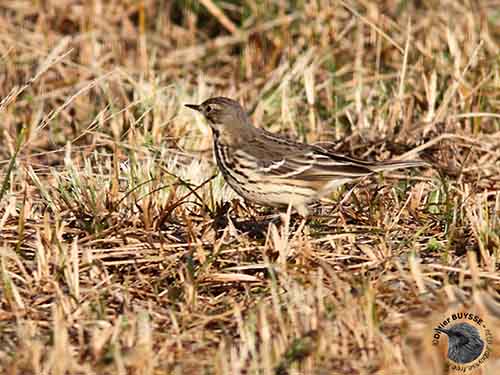
CALLS AND SONGS: SOUNDS BY XENO-CANTO
The Buff-bellied Pipit or American Pipit utters a high-pitched “sipit” or “sip” in flight, and a series of rapid, repeated “si-si-si-si-sif” when flushed. When alarmed near the nest, it utters a rising “pwisp”.
The song is given both from a perch and in flight. This is a rapid series of high-pitched notes often repeated in phrases “treeu-treeu-treeu” or “pleetrr-pleetrr-pleetrr”, “chwee-chwee”, “tsip-tsip-tsiru”. It usually continues for up to 15 seconds.
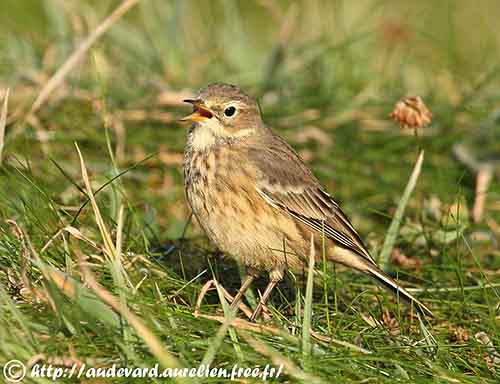
BEHAVIOUR IN THE WILD:
The Buff-bellied Pipit or American Pipit feeds primarily on various insects such as Orthoptera, Coleoptera, Hemiptera, Homoptera, Hymenoptera and larvae. It also takes spiders and mites (Acarina). Other invertebrates such as small molluscs and crustaceans are part of its diet, like small seeds and berries, but mainly in autumn and winter.
It forages while walking on the ground and picking at food items. In wet areas, it may wade in shallow water, searching for small aquatic invertebrates.
It usually wags its tail up and down, but also swings it from side to side, and nods the head at the same time, while walking and feeding.
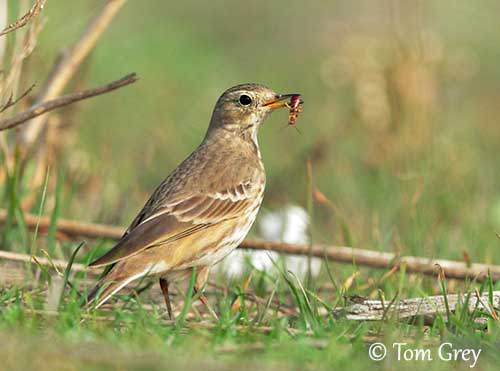
During winter, they may occur in large flocks in open fields. If disturbed, they take-off in unison, wheel and turn in the air before to return to their feeding behaviour.
The Buff-bellied Pipit or American Pipit is monogamous. The male performs aerial displays, rising and descending in long arc in the air while singing. During this display, wings and tail are raised and vibrating. There are several variations between species, and the nature of the display flight helps to identify the bird. Fights between males occur before pair-formation.
The Buff-bellied Pipit or American Pipit is migratory (see range). It moves southwards to winter in warmer climates. They leave their breeding grounds in late August/early September in Alaska. They arrive in California and Arizona between middle-late September and Middle October.
The breeding birds stay until mid-April in their wintering range. They usually arrive in Alaska between late April and early May.
The flight is powerful and undulating.
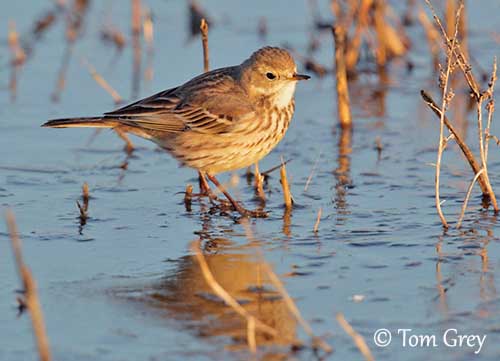
The nominate race “rubescens” is a vagrant to Europe, but the other races may also exhibit vagrancy patterns.
The Buff-bellied Pipit or American Pipit is seen sometimes in Cocos Island, SW Costa Rica. Observations of January 2005 mention this species resting on sandbar near a river’s mouth. Other reports mention this bird on the island as vagrant.
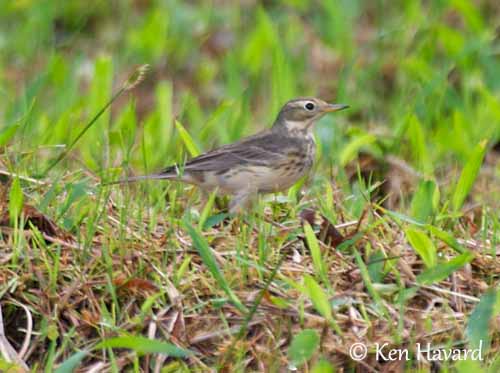
REPRODUCTION OF THIS SPECIES:
The breeding season occurs between April/May and mid-July.
The female builds the nest while the male brings materials. The nest is placed on the ground, in grass clump or under rock. This is a platform made with dead grass and sedge, and the inner cup is lined with horse hair and finer grass.
She lays 3-7 grey eggs with brown markings. She incubates during 14-15 days, and the male feeds her during this period. The chicks are brooded by the female during the first days, but they are fed by both adults. They fledge about 13-16 days after hatching.
PROTECTION / THREATS / STATUS:
The Buff-bellied Pipit or American Pipit is common in its habitat, and the species is widespread throughout the range. The global population is estimated at about 19/20,000,000 individuals.
This species is not currently threatened.
